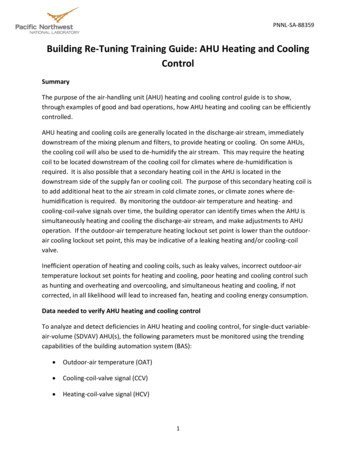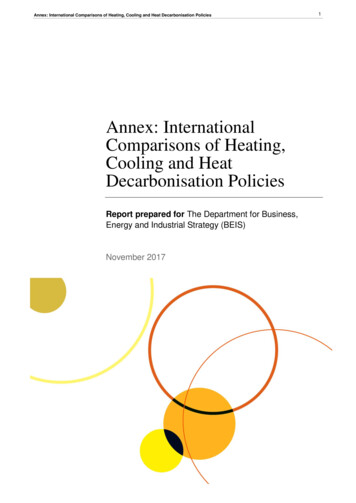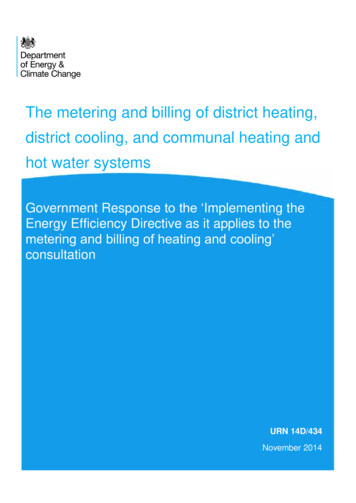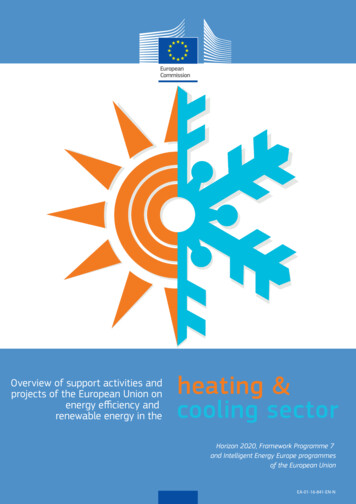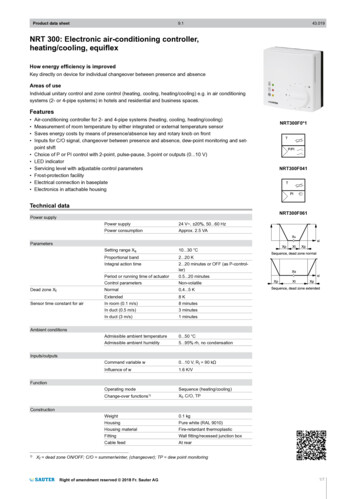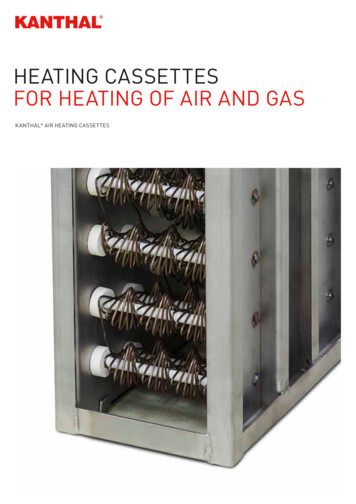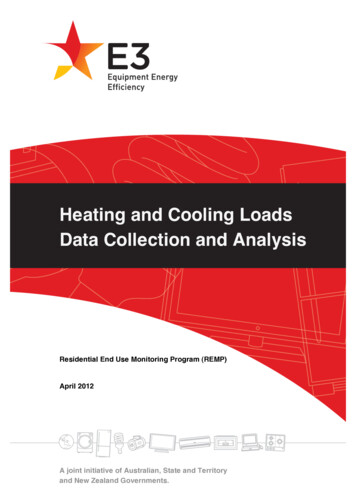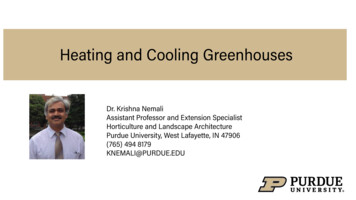
Transcription
Heating and Cooling GreenhousesDr. Krishna NemaliAssistant Professor and Extension SpecialistHorticulture and Landscape ArchitecturePurdue University, West Lafayette, IN 47906(765) 494 8179KNEMALI@PURDUE.EDU
Why temperature is important?LettuceAir temperature affects both growth anddays to flowering in greenhouse plantsBetween 50 and 80 F, plants grow fasterand flower earlier, when temperature isincreased60 FSalvia70 F
What is optimal temperature?
Greenhouse CoolingWithout ventilation and/orcooling temperature, agreenhouse can be 7 to 10 Chigher than outside95 F77 FH.S. Wein, 2009
Shade Cloth Temperature can be lowered by shadinggreenhouse This will reduce light transmission Usually used when cooling by othermethods does not reduce temperature tothe desired level If the cloth is meant for shading, then itshould be outside the structure formaximum reduction
Natural Ventilation Pressure gradients due to temperature and wind create naturalventilationo Hot air moves up creating low pressure and cool air movesto fill the spaceo Wind entering greenhouse pushes air outside Natural ventilation can be through both side-wall and roof. Thearea of side-wall and roof ventilation should be similar and eachaccounting 15 to 20% of surface area Ridge ventilation should make 60 angle to the roof Wind blowing over the roof creates vacuum on the leeward sideof ridge vent and air moves out Insect screens are used to cover openings, poses resistance towind movement Tall greenhouses keep hot air above plants (gutters at 12’ to 14’height) Do not operate horizontal air flow fans when using naturalventilationWindLeeward Side
Forced Ventilation Hot air is forced out of the greenhouse using exhaust fans Fans should not be spaced more than 25’ apart Fans should be placed on leeward side, if not add 10% to fan capacity. Aclear space of 4 to 5 fan diameters to be maintained in front of fans Louvers should be 1 to 1.5 times the diameter of fansExhaust Fan
Forced Ventilation: Fan Capacity A ventilation rate of 8-10 cubic feet of air per min for eachsquare foot area of greenhouse is desired to keepgreenhouse air within 5 F of outside temp (with activelygrowing plants) A 3000 square feet greenhouse requires ventilation rate of3000 8 24000 cubic feet of air to exhaust every minute Exhaust fans should be sized properly to ventilate 24000cubic feet per minuteExhaust Fan
Evaporative CoolingMoisture in the air Water gains temperaturefrom air to evaporate This lowers air temperature Evaporative pads reduce airtemperature by anadditional 5-10 FOutside air temperature
Evaporative Cooling: Pad Size Air velocity specifications:Aspen fiber (4-inch thick) -200 feet per minCorrugated cellulose (4-inch thick) -250 feet per min Pad area (square feet) needed will be determined by dividing air flowvolume by air velocity specification Exhaust fans designed to ventilate 24000 cubic feet per minute Pad area (for Aspen fiber pads): 24000 cubic feet per min / 200 ft per min 120 square feet Pad vertical height is between 2-8’ but usually 4’ is preferred. In theabove example, dimensions can be 30’ x 4’Cooling pads
Evaporative Cooling Preferred greenhouse length between fan and pad is 100to 150 feet Plan 50 gallons per minute of water flow per 100 squarefeet of pad area Plan 50 GPM pump capacity per 100 feet length of padsInstall a bleed-off to water sump to ensure thatsediments are discharged Pads are installed on the side of prevailing winds insummer Fan exhaust should be at least 50 feet from adjacentpads
Greenhouse Heating Heating is required to producecrops during Nov – Feb in theMidwest Average winter temperatures areclose to freezing (32 F) whileoptimal temperature for crops isaround 70 F
Maximize Solar Heat Gain On coldest days, 960 BTU per square feet areneeded in a day to keep optimal temperature Sunlight provides nearly 600 BTU per square feet ina day during winter Between 60 to 80 percent of heat comes from solarradiation Maximizing sunlight transmission into greenhouseis important to lower heating costsN
Types of Heat LossLong Wave Radiation1. Conduction2. Convection3. Radiation4. ration
Heat RequirementHeat requirement is calculated from heat losses due to conduction, convection, radiation and infiltration𝑄𝑄 𝑈𝑈 𝐴𝐴 (𝑇𝑇𝑖𝑖 𝑇𝑇𝑜𝑜 )Q Heat loss (BTU/hr) through conduction, convection, and radiationU ‘Overall’ heat transfer coefficient (BTU/hr ft2 F)A Surface area of glazing (ft2)𝑇𝑇𝑖𝑖 Inside temperature ( F)𝑇𝑇𝑜𝑜 Outside temperature ( F)Add 10% to account for infiltration losses
U-Value Smaller U values are betterThe value is experimentally determined for materialsU-values can vary; representative of a normal situationare provided in the tableValues can increase on windy and clear nightsSingle pane glass: 1.1Double plane glass: 0.6Double polythene: 0.7Polythene (IR coated) : 0.50Polycarbonate: 1.1Double polycarbonate: 0.56Concrete: 0.75
Surface Area of Glazing Material
Artificial Heat Gain Propane: 91,000 BTU/gal Gasoline 124,000 BTU/gal Wood (dry): 8,600 BTU/lb Electricity: 3,410 BTU/KWh Oil (#2): 140,000 BTU/gal Natural gas: 1000 BTU/ft3Unit Heater
Calculate Heat and Fuel RequirementHow much heat (BTU/hr) is needed to maintain 70 F in a greenhouse when outside air temperature is 36 F.The greenhouse is arch-shape with a surface area of 5000 square feet and covered with a doublepolyethylene with IR coating on inside. Propane is used as fuel to heat the greenhouse.1.2.3.4.5.6.7.𝑄𝑄 𝑈𝑈 𝐴𝐴 (𝑇𝑇𝑖𝑖 𝑇𝑇𝑜𝑜 )Q 0.5 5000 (70 – 36)Q 0.5 5000 (34)Q 85000 BTU/hrAdd 10% for infiltration lossesQ 85000 8500 93500 BTU/hr1 gal of propane provides 91000 BTUsTherefore, 93500/91000 1.03 gal of propane is used every hour
Bench Heating Used to provide optimal temperature to rootzone for germination, propagation and plantgrowthHot water at 35 to 40 C (95 to 104 F) iscirculated through 0.5 inch polyethylene tubingFlow rate should be high enough to minimizedifference between supply and return sides andavoid sedimentationTubing can be placed on the bench. Apolystyrene sheet at the bottom ensures heat isdirected towards rootsUsually 4-inch spacing between tubes, lessspacing if more temperature uniformity isdesired
Heated Hydroponic Solution Greenhouse was maintained at 55 Fbut heated solution at 70 F was usedto grow lettuce This reduced greenhouse heatingrequirement but maintained goodcrop growthHeated Solution(70 F)Unheated Solution(60/50 F)
Geothermal HeatingHeat pumpHeat distributionWarm waterAt least 6’ 100 ftCold water45 to 70 FwaterBoth passive and active systems existAbout 54 F is geothermal temperature between 6-10’ in the ground;Passive method can’t increase air temperature beyond 50-55 FActive method uses a heat pump. About 6-8 ton pump is needed (1 ton 12000 BTU/hr)Overall cost of installation can be close to 20000 for a 3000 to 5000 square feet areaAdd electrical energy cost of running heat pumps to monthly bill
Questions?
Evaporative Cooling: Pad Size. Cooling pads Air velocity specifications: Aspen fiber (4-inch thick) -200 feet per min Corrugated cellulose (4-inch thick) -250 feet per min Pad area (square feet) needed will be determined by dividing air flow volume by air velocity specification Exhaust fans designed to ventilate 24000 cubic feet per .

